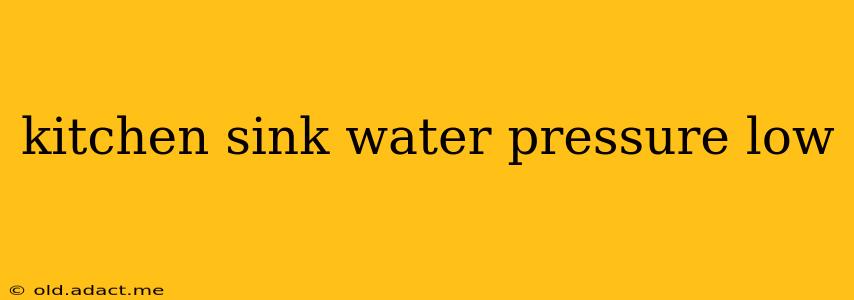Low water pressure in your kitchen sink is a frustrating problem, but thankfully, it's often solvable with some simple troubleshooting. This guide will walk you through the common causes and offer effective solutions to restore your sink's full water pressure. We'll even address some frequently asked questions to ensure you have a complete understanding of the issue.
Common Causes of Low Kitchen Sink Water Pressure
Several factors can contribute to low water pressure in your kitchen sink. These include:
- Clogged Aerator: The aerator, located at the end of your faucet spout, mixes air with water to create a smooth, aerated stream. Mineral buildup or debris can clog it, restricting water flow.
- Sediment Buildup in Pipes: Over time, sediment and mineral deposits can accumulate inside your pipes, narrowing the passage and reducing water pressure. This is particularly common in older homes.
- Low Water Pressure Throughout the House: If all your faucets experience low water pressure, the problem likely lies with your main water supply line, water meter, or even the municipal water supply.
- Partially Closed Valves: Check the shut-off valves under your sink. If either the hot or cold water valve is partially closed, it will significantly reduce water pressure.
- Kinked or Damaged Supply Lines: The flexible supply lines connecting your faucet to the shut-off valves can become kinked or damaged, restricting water flow.
- Faucet Issues: A faulty faucet cartridge or other internal components can restrict water flow. This is more likely if only the kitchen sink is affected and other faucets have normal pressure.
How to Fix Low Kitchen Sink Water Pressure
Let's tackle those potential problems step-by-step:
1. Check and Clean the Aerator
This is the easiest fix and often solves the problem. Unscrew the aerator (usually a small, cylindrical piece at the end of your faucet spout) and clean it thoroughly under running water. You can also use a small brush or soak it in vinegar to remove mineral deposits. Reassemble the aerator once it's clean.
2. Inspect the Shut-Off Valves
Locate the shut-off valves under your sink. Ensure both the hot and cold water valves are fully open. If they're partially closed, fully open them and check the water pressure.
3. Examine the Supply Lines
Carefully inspect the supply lines for kinks or damage. If you find any kinks, gently straighten them. If there's significant damage, replace the supply lines. This is a relatively simple DIY project, but if you're unsure, call a plumber.
4. Check for Low Water Pressure Throughout the House
If the low pressure affects all faucets, the problem is likely outside your sink. Check your water meter for any restrictions. If the problem persists, contact your local water utility company.
5. Consider Sediment Buildup
If cleaning the aerator and checking valves and supply lines doesn't resolve the issue, sediment buildup in your pipes might be the culprit. This often requires professional help to flush the lines or address more significant issues.
6. Investigate Faucet Malfunction
If the problem is isolated to your kitchen sink and other faucets work fine, your faucet may need repair or replacement. A faulty cartridge or other internal components can reduce water pressure.
Frequently Asked Questions (FAQs)
Q: My kitchen sink has low water pressure only on the hot water side. What could be causing this?
A: Low hot water pressure often points to issues within your hot water heater, such as sediment buildup in the tank, a faulty heating element, or a problem with the water inlet valve. You might need a professional plumber to assess and repair your hot water heater.
Q: How can I prevent low water pressure in my kitchen sink in the future?
A: Regular maintenance is key. Clean the aerator every few months, and consider having your pipes professionally flushed every few years, especially if you live in an area with hard water.
Q: When should I call a plumber for low kitchen sink water pressure?
A: If troubleshooting doesn't resolve the issue, if the problem affects your entire house, or if you're uncomfortable working with plumbing, it's best to call a qualified plumber. They have the expertise and tools to diagnose and fix more complex problems.
By following these steps and addressing the potential causes, you can effectively troubleshoot low kitchen sink water pressure and enjoy a fully functional sink once again. Remember, regular maintenance is key to preventing future problems.
